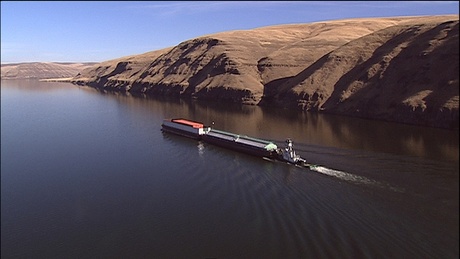forum
library
tutorial
contact

Dredging's Impact on Snake River Fish Quietly Debated
by Rich LandersSpokesman-Review, March 27, 2013
|
the film forum library tutorial contact |

|
Dredging's Impact on Snake River Fish Quietly Debatedby Rich LandersSpokesman-Review, March 27, 2013 |
U.S. Army Corps of Engineers hears objections to its plan
to dredge lower Snake River navigation channel
 RIVERS - The Corps of Engineers' plan to dredge portions of the Lower Snake River is a touchy issue politically, economically and in regard so salmon and steelhead.
RIVERS - The Corps of Engineers' plan to dredge portions of the Lower Snake River is a touchy issue politically, economically and in regard so salmon and steelhead.
I know this because none of the fisheries biologists I contacted this month would comment. They all referred me to managers who referred me to documents their agencies were filing - on or after the public comment period that ended Tuesday for environmental impact statement on the Corps' sediment management plan,
The Idaho Department of Fish and Game submitted comments to the Governor's Office to be incorporated into a package of State comments on the draft EIS.
Dredging is proposed at three sites in Lower Granite Reservoir and below Ice Harbor Dam because sediment buildup, an expected problem associated with dams, is interfering with commercial navigation.
Sam Mace of Save our Wild Salmon, says there's a better idea that would be cheaper and more sustainable in the long run: Breach the dams.
Maintenance and operations costs for the lower Snake River barge transportation corridor greatly exceed its economic benefits, she says.
"With a growing project backlog and deepening federal deficits, these new analyses raise serious questions about the lower Snake waterway's economic viability, and its burden to local communities and American taxpayers."
Read her comment to the Corps as well as her entire message (see below), which makes the case that farmers also would benefit from bagging the aging dams. The byproduct of such economic responsibility would be boosting endangered salmon runs with a natural, free-flowing river.
Related Pages:
Energy Intensities of Freight: Barge, Truck and Railroad US Department of Energy, Transportation Energy Data Book
Snake River Barge Rates by Tidewater Barge Lines, Inc., Summer 1999
Independent analyses challenge the economic viability and future of lower Snake River waterway
Official comments submitted to the United States Army Corps of Engineers District Office in Walla Walla today demonstrate that maintenance and operations costs for the lower Snake River transportation corridor greatly exceed its economic benefits. With a growing project backlog and deepening federal deficits, these new analyses raise serious questions about the lower Snake waterway's economic viability, and its burden to local communities and American taxpayers.
Last December, the Army Corps released a 1,500-page Draft Environmental Impact Statement proposing to dredge hundreds of thousands of cubic yards of sediment in Lower Granite reservoir on the Snake River along the Idaho/Washington border. The plan quickly came under fire from local citizens who question the waterway's underlying economics. The Corps' $16 million document proposes to spend $39 million or more over the next 10 years.
"Waterway transportation on the lower Snake cannot be justified today", said Sam Mace, Inland Northwest Project Director of Save Our wild Salmon. "Costs are rising, use is dropping, and taxpayers won't continue to foot this bill. Businesses need a reliable, affordable transportation system, and we need to focus our limited resources on fiscally responsible transportation options that meet community needs and better protect endangered salmon."
In an independent evaluation of the plan, Natural Resource Economics found that the Army Corps completely failed to substantiate its proposed expenditures and actions, or to provide a cost-benefit analysis. Rather, the available information shows that the plan "would have a negative net effect on national economic development, i.e., its costs would exceed its benefits."
Save Our wild Salmon supports a reliable, affordable transportation network for farmers and other businesses in eastern Washington and northern Idaho based on rails and roads. "We'll keep working with farmers and others in eastern Washington to find shared solutions that strengthen our economy, meet the needs of communities and restore endangered salmon and steelhead," said Mace. "By hiding the economic and fiscal facts, the Army Corps is doing a disservice to the people and the economy of Lewiston/Clarkston and eastern Washington."
learn more on topics covered in the film
see the video
read the script
learn the songs
discussion forum
